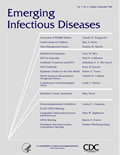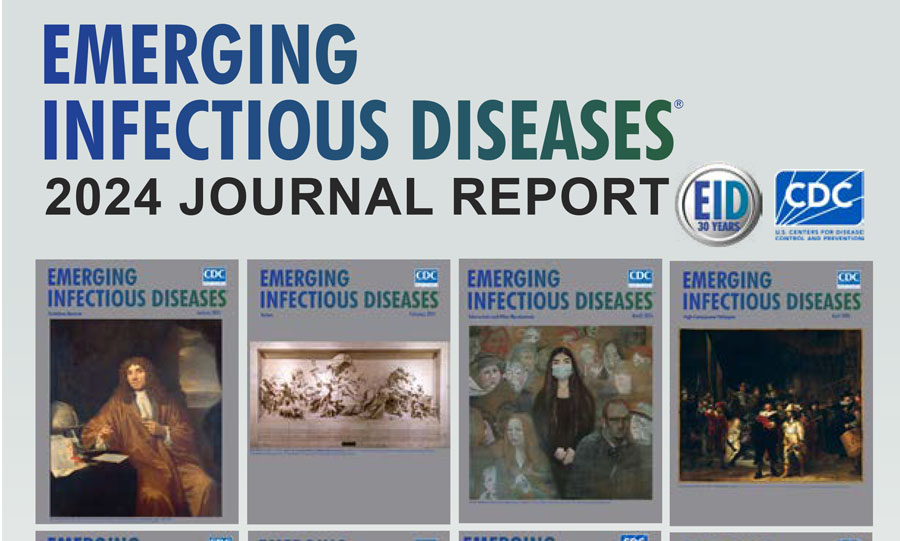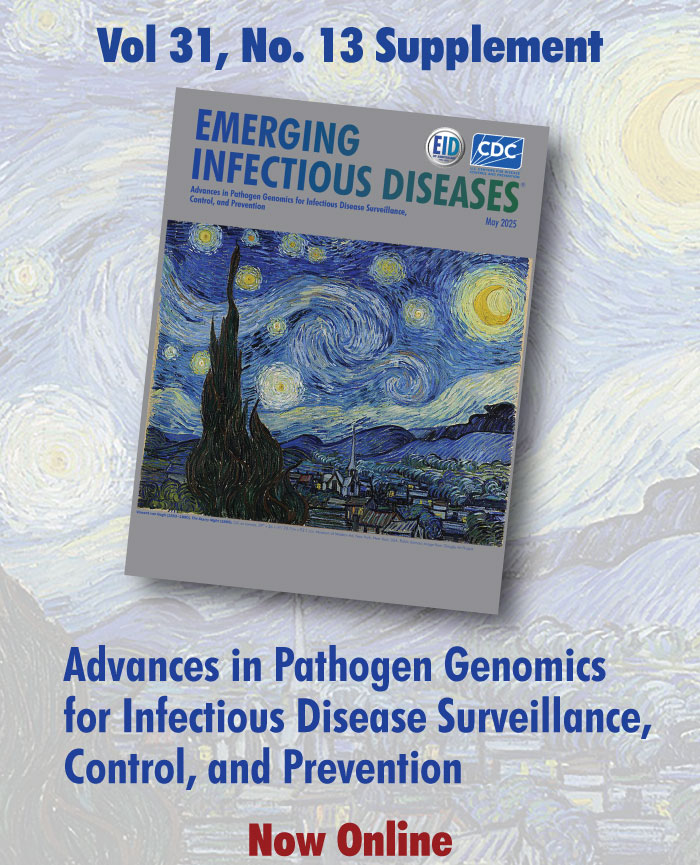Synopses
The Ascension of Wildlife Rabies: A Cause for Public Health Concern or Intervention?
The epidemiology of rabies in the United States has changed substantially during the half century, as the source of the disease has changed from domesticated animals to wildlife, principally raccoons, skunks, foxes, and bats. Moreover, the changes observed among affected wildlife populations have not occurred without human influence. Rather, human attraction to the recreational and economic resources provided by wildlife has contributed to the reemergence of rabies as a major zoonosis. Although human deaths caused by rabies have declined recently to an average of one or two per year, the estimated costs associated with the decrease in deaths amount to hundreds of millions of dollars annually. In future efforts to control rabies harbored by free-ranging animal reservoirs, public health professionals will have to apply imaginative, safe, and cost-effective solutions to this age-old malady in addition to using traditional measures.
| EID | Rupprecht CE, Smith JS, Fekadu M. The Ascension of Wildlife Rabies: A Cause for Public Health Concern or Intervention?. Emerg Infect Dis. 1995;1(4):107-114. https://doi.org/10.3201/eid0104.950401 |
|---|---|
| AMA | Rupprecht CE, Smith JS, Fekadu M. The Ascension of Wildlife Rabies: A Cause for Public Health Concern or Intervention?. Emerging Infectious Diseases. 1995;1(4):107-114. doi:10.3201/eid0104.950401. |
| APA | Rupprecht, C. E., Smith, J. S., & Fekadu, M. (1995). The Ascension of Wildlife Rabies: A Cause for Public Health Concern or Intervention?. Emerging Infectious Diseases, 1(4), 107-114. https://doi.org/10.3201/eid0104.950401. |
Diagnosis of Tuberculosis in Children: Increased Need for Better Methods
In the last decade tuberculosis (TB) has reemerged as a major worldwide public health hazard with increasing incidence among adults and children. Although cases among children represent a small percentage of all TB cases, infected children are a reservoir from which many adult cases will arise. TB diagnosis in children usually follows discovery of a case in an adult, and relies on tuberculin skin testing, chest radiograph, and clinical signs and symptoms. However, clinical symptoms are nonspecific, skin testing and chest radiographs can be difficult to interpret, and routine laboratory tests are not helpful. Although more rapid and sensitive laboratory testing, which takes into account recent advances in molecular biology, immunology, and chromatography, is being developed, the results for children have been disappointing. Better techniques would especially benefit children and infants in whom early diagnosis is imperative for preventing progressive TB.
| EID | Khan EA, Starke JR. Diagnosis of Tuberculosis in Children: Increased Need for Better Methods. Emerg Infect Dis. 1995;1(4):115-123. https://doi.org/10.3201/eid0104.950402 |
|---|---|
| AMA | Khan EA, Starke JR. Diagnosis of Tuberculosis in Children: Increased Need for Better Methods. Emerging Infectious Diseases. 1995;1(4):115-123. doi:10.3201/eid0104.950402. |
| APA | Khan, E. A., & Starke, J. R. (1995). Diagnosis of Tuberculosis in Children: Increased Need for Better Methods. Emerging Infectious Diseases, 1(4), 115-123. https://doi.org/10.3201/eid0104.950402. |
Data Management Issues for Emerging Diseases and New Tools for Managing Surveillance and Laboratory Data
| EID | Martin SM, Bean NH. Data Management Issues for Emerging Diseases and New Tools for Managing Surveillance and Laboratory Data. Emerg Infect Dis. 1995;1(4):124-128. https://doi.org/10.3201/eid0104.950403 |
|---|---|
| AMA | Martin SM, Bean NH. Data Management Issues for Emerging Diseases and New Tools for Managing Surveillance and Laboratory Data. Emerging Infectious Diseases. 1995;1(4):124-128. doi:10.3201/eid0104.950403. |
| APA | Martin, S. M., & Bean, N. H. (1995). Data Management Issues for Emerging Diseases and New Tools for Managing Surveillance and Laboratory Data. Emerging Infectious Diseases, 1(4), 124-128. https://doi.org/10.3201/eid0104.950403. |
Dispatches
Helicobacter hepaticus, a Recently Recognized Bacterial Pathogen, Associated with Chronic Hepatitis and Hepatocellular Neoplasia in Laboratory Mice
| EID | Rice JM. Helicobacter hepaticus, a Recently Recognized Bacterial Pathogen, Associated with Chronic Hepatitis and Hepatocellular Neoplasia in Laboratory Mice. Emerg Infect Dis. 1995;1(4):129-131. https://doi.org/10.3201/eid0104.950404 |
|---|---|
| AMA | Rice JM. Helicobacter hepaticus, a Recently Recognized Bacterial Pathogen, Associated with Chronic Hepatitis and Hepatocellular Neoplasia in Laboratory Mice. Emerging Infectious Diseases. 1995;1(4):129-131. doi:10.3201/eid0104.950404. |
| APA | Rice, J. M. (1995). Helicobacter hepaticus, a Recently Recognized Bacterial Pathogen, Associated with Chronic Hepatitis and Hepatocellular Neoplasia in Laboratory Mice. Emerging Infectious Diseases, 1(4), 129-131. https://doi.org/10.3201/eid0104.950404. |
Hemolytic Uremic Syndrome Due to Shiga-like Toxin Producing Escherichia coli O48:H21 in South Australia
| EID | Goldwater PN, Bettelheim KA. Hemolytic Uremic Syndrome Due to Shiga-like Toxin Producing Escherichia coli O48:H21 in South Australia. Emerg Infect Dis. 1995;1(4):132-133. https://doi.org/10.3201/eid0104.950405 |
|---|---|
| AMA | Goldwater PN, Bettelheim KA. Hemolytic Uremic Syndrome Due to Shiga-like Toxin Producing Escherichia coli O48:H21 in South Australia. Emerging Infectious Diseases. 1995;1(4):132-133. doi:10.3201/eid0104.950405. |
| APA | Goldwater, P. N., & Bettelheim, K. A. (1995). Hemolytic Uremic Syndrome Due to Shiga-like Toxin Producing Escherichia coli O48:H21 in South Australia. Emerging Infectious Diseases, 1(4), 132-133. https://doi.org/10.3201/eid0104.950405. |
Does Treatment of Bloody Diarrhea due to Shigella dysenteriae Type 1 with Ampicilin Precipitate Hemolytic Uremic Syndrome?
| EID | Saeed AA, El Bushra HE, Al-Hamdan NA. Does Treatment of Bloody Diarrhea due to Shigella dysenteriae Type 1 with Ampicilin Precipitate Hemolytic Uremic Syndrome?. Emerg Infect Dis. 1995;1(4):134-137. https://doi.org/10.3201/eid0104.950406 |
|---|---|
| AMA | Saeed AA, El Bushra HE, Al-Hamdan NA. Does Treatment of Bloody Diarrhea due to Shigella dysenteriae Type 1 with Ampicilin Precipitate Hemolytic Uremic Syndrome?. Emerging Infectious Diseases. 1995;1(4):134-137. doi:10.3201/eid0104.950406. |
| APA | Saeed, A. A., El Bushra, H. E., & Al-Hamdan, N. A. (1995). Does Treatment of Bloody Diarrhea due to Shigella dysenteriae Type 1 with Ampicilin Precipitate Hemolytic Uremic Syndrome?. Emerging Infectious Diseases, 1(4), 134-137. https://doi.org/10.3201/eid0104.950406. |
An Outbreak of Hemoytic Uremic Syndrome Associated with Antibiotic Treatment of Hospital Inpatients for Dysentery
| EID | Al-Qarawi S, Fontaine RE, Al-Qahtani M. An Outbreak of Hemoytic Uremic Syndrome Associated with Antibiotic Treatment of Hospital Inpatients for Dysentery. Emerg Infect Dis. 1995;1(4):138-140. https://doi.org/10.3201/eid0104.950407 |
|---|---|
| AMA | Al-Qarawi S, Fontaine RE, Al-Qahtani M. An Outbreak of Hemoytic Uremic Syndrome Associated with Antibiotic Treatment of Hospital Inpatients for Dysentery. Emerging Infectious Diseases. 1995;1(4):138-140. doi:10.3201/eid0104.950407. |
| APA | Al-Qarawi, S., Fontaine, R. E., & Al-Qahtani, M. (1995). An Outbreak of Hemoytic Uremic Syndrome Associated with Antibiotic Treatment of Hospital Inpatients for Dysentery. Emerging Infectious Diseases, 1(4), 138-140. https://doi.org/10.3201/eid0104.950407. |
Epidemic Cholera in the New World: Translating Field Epidemiology into New Prevention Strategies
| EID | Tauxe RV, Mintz ED, Quick RE. Epidemic Cholera in the New World: Translating Field Epidemiology into New Prevention Strategies. Emerg Infect Dis. 1995;1(4):141-146. https://doi.org/10.3201/eid0104.950408 |
|---|---|
| AMA | Tauxe RV, Mintz ED, Quick RE. Epidemic Cholera in the New World: Translating Field Epidemiology into New Prevention Strategies. Emerging Infectious Diseases. 1995;1(4):141-146. doi:10.3201/eid0104.950408. |
| APA | Tauxe, R. V., Mintz, E. D., & Quick, R. E. (1995). Epidemic Cholera in the New World: Translating Field Epidemiology into New Prevention Strategies. Emerging Infectious Diseases, 1(4), 141-146. https://doi.org/10.3201/eid0104.950408. |
Are North American Bunyamwera Serogroup Viruses Etiologic Agents of Human Congential Defects of the Central Nervous System?
| EID | Calisher CH, Sever JL. Are North American Bunyamwera Serogroup Viruses Etiologic Agents of Human Congential Defects of the Central Nervous System?. Emerg Infect Dis. 1995;1(4):147-151. https://doi.org/10.3201/eid0104.950409 |
|---|---|
| AMA | Calisher CH, Sever JL. Are North American Bunyamwera Serogroup Viruses Etiologic Agents of Human Congential Defects of the Central Nervous System?. Emerging Infectious Diseases. 1995;1(4):147-151. doi:10.3201/eid0104.950409. |
| APA | Calisher, C. H., & Sever, J. L. (1995). Are North American Bunyamwera Serogroup Viruses Etiologic Agents of Human Congential Defects of the Central Nervous System?. Emerging Infectious Diseases, 1(4), 147-151. https://doi.org/10.3201/eid0104.950409. |
Lymphocytic Choriomeningitis Virus:An Unrecognized Teratogenic Pathogen
| EID | Barton LL, Peters C, Ksiazek T. Lymphocytic Choriomeningitis Virus:An Unrecognized Teratogenic Pathogen. Emerg Infect Dis. 1995;1(4):152-153. https://doi.org/10.3201/eid0104.950410 |
|---|---|
| AMA | Barton LL, Peters C, Ksiazek T. Lymphocytic Choriomeningitis Virus:An Unrecognized Teratogenic Pathogen. Emerging Infectious Diseases. 1995;1(4):152-153. doi:10.3201/eid0104.950410. |
| APA | Barton, L. L., Peters, C., & Ksiazek, T. (1995). Lymphocytic Choriomeningitis Virus:An Unrecognized Teratogenic Pathogen. Emerging Infectious Diseases, 1(4), 152-153. https://doi.org/10.3201/eid0104.950410. |
Commentaries
Hemolytic Uremic Syndrome
| EID | Beers M, Cameron S. Hemolytic Uremic Syndrome. Emerg Infect Dis. 1995;1(4):154-155. https://doi.org/10.3201/eid0104.950411 |
|---|---|
| AMA | Beers M, Cameron S. Hemolytic Uremic Syndrome. Emerging Infectious Diseases. 1995;1(4):154-155. doi:10.3201/eid0104.950411. |
| APA | Beers, M., & Cameron, S. (1995). Hemolytic Uremic Syndrome. Emerging Infectious Diseases, 1(4), 154-155. https://doi.org/10.3201/eid0104.950411. |
About the Cover
Volume 1, Issue 4
News and Notes
Guidelines on the Risk for Transmission of Infectious Agents During Xenotransplants
| EID | Chapman LE. Guidelines on the Risk for Transmission of Infectious Agents During Xenotransplants. Emerg Infect Dis. 1995;1(4):156. https://doi.org/10.3201/eid0104.950412 |
|---|---|
| AMA | Chapman LE. Guidelines on the Risk for Transmission of Infectious Agents During Xenotransplants. Emerging Infectious Diseases. 1995;1(4):156. doi:10.3201/eid0104.950412. |
| APA | Chapman, L. E. (1995). Guidelines on the Risk for Transmission of Infectious Agents During Xenotransplants. Emerging Infectious Diseases, 1(4), 156. https://doi.org/10.3201/eid0104.950412. |
Emerging Infectious Diseases Featured at ICAAC/IDSA Meeting
| EID | Emerging Infectious Diseases Featured at ICAAC/IDSA Meeting. Emerg Infect Dis. 1995;1(4):156. https://doi.org/10.3201/eid0104.950413 |
|---|---|
| AMA | Emerging Infectious Diseases Featured at ICAAC/IDSA Meeting. Emerging Infectious Diseases. 1995;1(4):156. doi:10.3201/eid0104.950413. |
| APA | (1995). Emerging Infectious Diseases Featured at ICAAC/IDSA Meeting. Emerging Infectious Diseases, 1(4), 156. https://doi.org/10.3201/eid0104.950413. |
Building a Geographic Information Systems (GIS) Public Health Infrastructure for Research and Control of Tropical Diseases
| EID | Hightower AW, Kline RE. Building a Geographic Information Systems (GIS) Public Health Infrastructure for Research and Control of Tropical Diseases. Emerg Infect Dis. 1995;1(4):156. https://doi.org/10.3201/eid0104.950414 |
|---|---|
| AMA | Hightower AW, Kline RE. Building a Geographic Information Systems (GIS) Public Health Infrastructure for Research and Control of Tropical Diseases. Emerging Infectious Diseases. 1995;1(4):156. doi:10.3201/eid0104.950414. |
| APA | Hightower, A. W., & Kline, R. E. (1995). Building a Geographic Information Systems (GIS) Public Health Infrastructure for Research and Control of Tropical Diseases. Emerging Infectious Diseases, 1(4), 156. https://doi.org/10.3201/eid0104.950414. |
APHA Session Features Emerging Infections
| EID | Favero MS. APHA Session Features Emerging Infections. Emerg Infect Dis. 1995;1(4):157. https://doi.org/10.3201/eid0104.950415 |
|---|---|
| AMA | Favero MS. APHA Session Features Emerging Infections. Emerging Infectious Diseases. 1995;1(4):157. doi:10.3201/eid0104.950415. |
| APA | Favero, M. S. (1995). APHA Session Features Emerging Infections. Emerging Infectious Diseases, 1(4), 157. https://doi.org/10.3201/eid0104.950415. |
Southeast Asia Intercountry Consultative Meeting on Prevention and Control of New, Emerging, and Reemerging Infectious Diseases
| EID | Plianbangchang S. Southeast Asia Intercountry Consultative Meeting on Prevention and Control of New, Emerging, and Reemerging Infectious Diseases. Emerg Infect Dis. 1995;1(4):158. https://doi.org/10.3201/eid0104.950416 |
|---|---|
| AMA | Plianbangchang S. Southeast Asia Intercountry Consultative Meeting on Prevention and Control of New, Emerging, and Reemerging Infectious Diseases. Emerging Infectious Diseases. 1995;1(4):158. doi:10.3201/eid0104.950416. |
| APA | Plianbangchang, S. (1995). Southeast Asia Intercountry Consultative Meeting on Prevention and Control of New, Emerging, and Reemerging Infectious Diseases. Emerging Infectious Diseases, 1(4), 158. https://doi.org/10.3201/eid0104.950416. |





